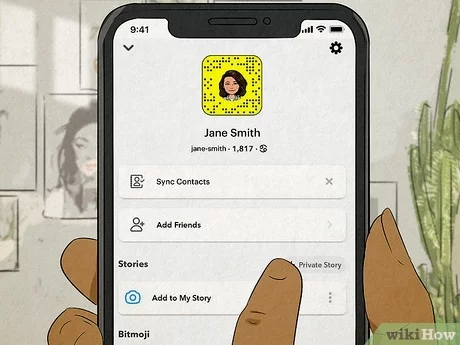
Understanding the Lock Icon on Snapchat
What is a Private Story?
A Private Story on Snapchat is a special type of story that can only be viewed by selected friends. When you see a lock icon next to a story, it indicates that the content is not available to everyone on the user’s friends list. Instead, only those who have been specifically chosen by the user can view the story. This feature is particularly useful for sharing more personal or sensitive content without the risk of it being seen by a broader audience.
How Does the Lock Icon Work?
The lock icon appears only on stories, not on individual snaps. If you see a purple lock, it means you have not yet viewed the Private Story, while a gray lock indicates that you have already seen it. This visual cue helps users quickly identify which stories are restricted and whether they have accessed them.
Why Use Private Stories?
There are several reasons why someone might choose to create a Private Story:
- Control Over Audience: Users can select exactly who gets to see their stories, which is ideal for sharing content that may not be suitable for all friends.
- Privacy: For individuals who may have random friends on Snapchat, Private Stories provide a layer of security for personal information or activities.
- Selective Sharing: Users might want to share specific experiences with only a few close friends, such as a party or a trip, without broadcasting it to everyone.
How to Create a Private Story
Creating a Private Story on Snapchat is straightforward. Here’s how to do it:
- Open the Snapchat app and tap on your profile icon.
- Select the option labeled “+ New Story.”
- Choose “New Private Story” from the menu.
- Follow the on-screen instructions to select friends who will have access to your Private Story.
- Add content to your story as you normally would.
- Once completed, only the selected friends will be able to view the story.
Differences Between Private Stories and Other Features
It’s important to note that Private Stories are distinct from the “My Eyes Only” feature on Snapchat. While Private Stories restrict who can view the content, “My Eyes Only” is a secure area within the app where users can store Snaps that they do not want anyone else to see. Access to “My Eyes Only” requires a passcode, adding an extra layer of security.
The Importance of Privacy on Social Media
The Growing Need for Privacy
In an age where social media is ubiquitous, privacy has become a top concern for many users. Snapchat, with its ephemeral messaging and stories, has built its brand around the idea of temporary sharing. However, the need for privacy extends beyond just the temporary nature of snaps. Users want to control who sees their content, especially when sharing personal moments.
Privacy Features on Snapchat
Snapchat offers several features aimed at protecting user privacy:
- Ephemeral Messaging: Snaps disappear after being viewed, reducing the risk of content being saved or shared without consent.
- Customizable Friend Lists: Users can categorize friends into different lists, allowing for more controlled sharing.
- Ghost Mode: This feature allows users to hide their location on Snap Map, ensuring that only selected friends can see where they are.
- Private Stories: As discussed, these allow users to share stories with a select group, providing an additional layer of privacy.
Creating Engaging Private Stories
Tips for Crafting Private Stories
Creating an engaging Private Story involves more than just restricting access. Here are some tips to make your Private Stories more appealing:
- Thematic Content: Choose a theme for your Private Story, such as a vacation, a special event, or a hobby. This consistency can make your story more engaging.
- Interactive Snaps: Use Snapchat’s features like polls, questions, and music to make your snaps interactive. This encourages friends to engage with your content.
- Behind-the-Scenes Content: Share exclusive behind-the-scenes moments that you wouldn’t post on your public story. This can create a sense of intimacy and exclusivity.
- Frequent Updates: Regularly update your Private Story to keep it fresh and interesting. This will encourage your selected friends to check in regularly.
- Use Filters and Lenses: Snapchat is known for its fun filters and lenses. Use these creatively to enhance your snaps and make them more visually appealing.
Engaging Your Audience
Engagement is key when sharing content, even in a Private Story. Here are some strategies to keep your audience interested:
- Ask Questions: Encourage your friends to respond to your snaps with questions or comments. This can foster a dialogue and make the experience more interactive.
- Share Personal Stories: Personal anecdotes can create a stronger connection with your audience. Sharing your thoughts and feelings can make your Private Story feel more relatable.
- Highlight Friend Contributions: If your friends are part of the story, highlight their contributions. This can make the experience feel more inclusive and collaborative.
Managing Your Private Stories
Editing and Deleting Private Stories
Managing your Private Stories is essential for keeping your content relevant and appropriate. Here’s how to edit or delete them:
- Editing Your Private Story: To change who can view your Private Story, go to your profile, tap on the Private Story, and select “Edit Story.” From there, you can add or remove friends.
- Deleting a Private Story: If you want to remove a Private Story entirely, go to your profile, tap on the story, and select “Delete Story.” This action will remove the story for all viewers.
- Temporary Stories: Remember that Private Stories are temporary, just like regular stories. They will disappear after 24 hours unless you save them.
Privacy Settings and Notifications
To enhance your privacy further, consider adjusting your Snapchat settings:
- Who Can Contact Me: Set your preferences for who can send you snaps and messages. You can choose between “Everyone,” “My Friends,” or “My Friends Except…” for more control.
- Story Privacy: Ensure your story settings reflect your privacy preferences. You can choose to share your story with “My Friends,” “Custom,” or “Public.”
- Notifications: Manage your notification settings to avoid unwanted interruptions. You can choose to receive notifications for stories, messages, and friend requests.
Frequently Asked Questions (FAQ)
What does the lock icon mean on Snapchat?
The lock icon indicates that the story is a Private Story, viewable only by selected friends.
How can I tell if I have viewed a Private Story?
A purple lock means you have not viewed the story, while a gray lock indicates that you have already seen it.
Can anyone see my Private Story if they are not selected?
No, friends who are not selected to view the Private Story will not know it exists.
How many Private Stories can I create?
You can create up to 20 Private Stories at a time on Snapchat.
Is a Private Story the same as “My Eyes Only”?
No, a Private Story is for sharing content with selected friends, while “My Eyes Only” is a secure area for storing Snaps privately.
Conclusion
The lock icon on Snapchat plays a crucial role in maintaining user privacy and control over content sharing. By allowing users to create Private Stories, Snapchat empowers individuals to share their experiences selectively, enhancing the overall user experience. Understanding how to utilize this feature effectively can lead to more meaningful interactions on the platform.
| Feature | Description |
|---|---|
| Private Story | A story viewable only by selected friends. |
| Lock Icon | Indicates that a story is private; purple means unviewed, gray means viewed. |
| Audience Control | Users can select who sees their stories, enhancing privacy. |
| Creation Limit | Up to 20 Private Stories can be created at once. |
| Distinction | Private Stories are different from “My Eyes Only,” which is for storing Snaps securely. |
For more detailed information, you can refer to the Snapchat Help Center for guidance on account features and privacy settings.


